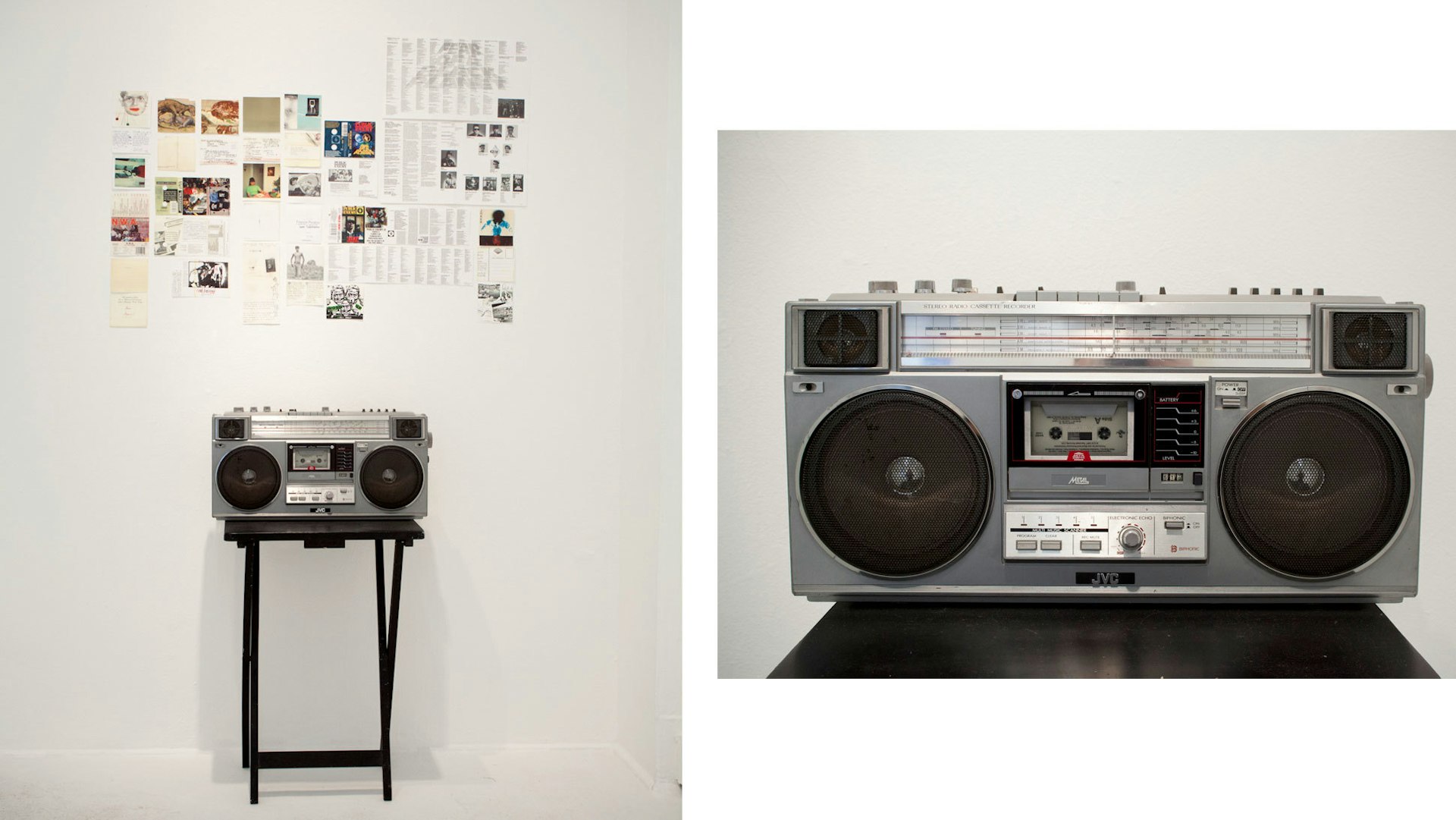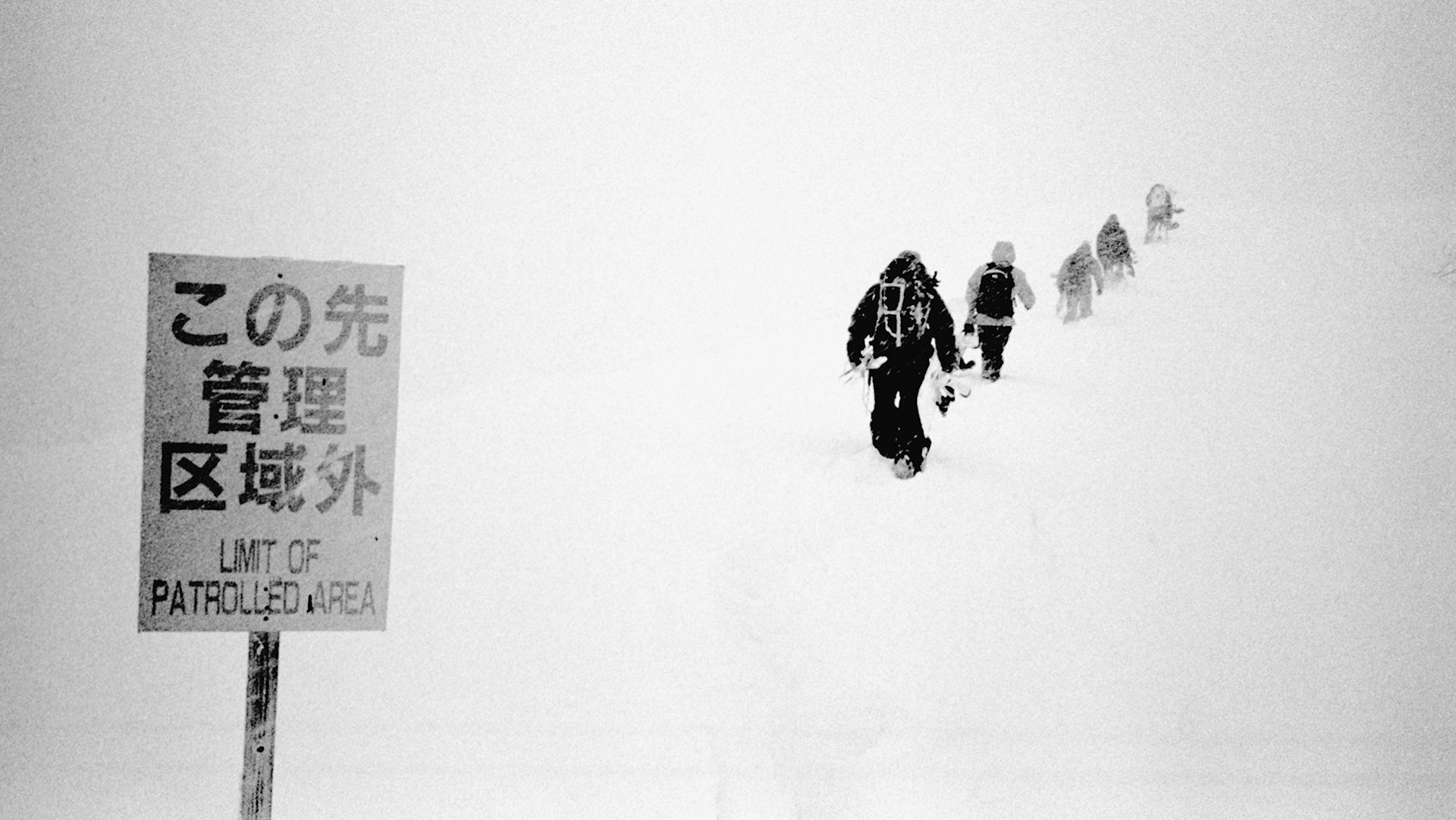
Jocko Weyland
- Text by Shelley Jones
- Photography by Ever Gold Gallery
Jocko Weyland is a hoarder. As an artist, archivist, writer, skater and ‘zine-maker, he’s spent his life collecting the things he’s curious about and finding the correlations or threads between them.
His latest show Crackle, Hiss and Scrawl at the rad Ever Gold gallery in San Francisco, features a collection of approximately 200 of his cassette tapes, from 1980-2005, playing on an old sony boom box, with their homemade or store-bought wrappings and listings adorning the surrounding walls.
According to Ever Gold: “Leaning towards an era-specific documentation based on a catholic definition of “punk”, from Amebix to the Zero Boys to the Birthday Party and X-Mal Deutschland, this surround sound experience also features mainstream inclusions such as Black Sabbath and The Who, with not-infrequent forays into the outer limits represented by the likes of Aisha Kandisha’s Jarring Effects, Test Dept., and Charles Ives.”
We caught up with the prolific collector and maker, who currently lives in Tucson, Arizona where he is curator-in-residence at the Museum of Contemporary Art, Tucson, to find out more about his sonic-visual installation.
How did the Crackle, Hiss and Scrawl show come about?
The cassettes started getting made or given to me or bought in Estes Park, Colorado, and have come along from there to Hawaii to California to New York, now going on thirty years. From the first one I made in 1982 – the archetypical punk rock starter kit – a 90-minute Memorex of the Sex Pistols’ Never Mind the Bollocks, the Dead Kennedys’ Fresh Fruit for Rotting Vegetables, and most of Black Market Clash, to the most recent, a Party Store Detroit hardcore sampler Allison Busch (of Awesome Color and more recently Red Dawn 2 and Call of the Wild) gave me a couple of years ago. In 2006 I put everything in storage including the cassettes and hadn’t seen or heard them since, but along the way the idea began to percolate. I had this somewhat inexplicable desire to see all those covers, handmade and store-bought, made out of photographs, postcards, flyers, art-show announcements, and all the pieces of paper inside with the song titles written on them, on a wall, or preferably, a few walls. And have an old boom box playing one tape at time, from roughly A to Z (with the compilation tapes coming after Z) in the corner of the room. A very simple concept, possibly too simple and literal, but I got that notion and it kept swimming around in my mind and they were sitting in that storage space by the Brooklyn Navy Yard and it just wouldn’t go away.
Are there any recurring themes or styles running through all the pieces?
Well I wouldn’t call them “pieces”, they are just the actual thing and not “art”. Though to be honest they are colour photocopies of the actual things because the putting up the actual things with all their different paper weights and thicknesses would have been a logistical nightmare. So they are documents, copies of historical artifacts, I suppose that’s the right way to put it. Well one theme is – ha – punk rock. A lot of it. The usual suspects: Black Flag, Minor Threat, Crass, Flux, Amebix, Double O, SSD, and so on and so on. That’s the “core” (pun intended) of the show. But then – musically – there’s so much around that. Everything from Brahms and John Cage to Nina Hagen, Yma Sumac, and Deviation Social, all the diverse sounds that were floating around that weren’t “punk” but that punk led you to if you were curious.
That’s what’s on the tapes – the sounds – but what’s on the covers, that’s all over the place. My own magic marker drawings copying the covers from the LPs (the first Killing Joke record) to postcards of Southern Spain and France my mother sent me in the 1980s and early 1990s and postcards from my sister in London and Berlin around that same time, to art show cards from New York galleries for everybody from Francis Picabia to Nan Goldin, to stickers and pieces of grey construction paper. All these materials were made into that two-fold shape to fit inside the cassette case. I’m not sure about themes but art and travel and whatever scrap might be lying around that could be used for that – what was available and looked “good” – all those things come together in a really varied and assorted everything-and-the-kitchen-sink-but-somehow-related aesthetic.
Can you describe some of your favorite cassettes from the show?
There are so many serendipitous and humorous combinations and odd neighbours, like that Mozart is next to Motley Crue. One of my favourites is a Love and Rockets/Sisters of Mercy tape Phil E. made, about 1987, I’d guess. The cover is a “poem” Phil wrote, and next to it is a postcard my sister Michele sent with a Paul Klee painting and snippets of her handwriting on the other side with “this Klee stuff” and “off running to the post office”. And what’s funnier are the mixes on the tapes, like the Klee one that’s Led Zeppelin on one side and the Adolescents, Bad Religion, Crucifix and Symbol Six on the other. A battle of epic proportions, old versus new. A couple other favorites – a postcard of flowers that includes a tape that’s Grace Jones on one side and the Rolling Stones on the other, and one utilising Zorlac stickers and ransom-style letters cut into “Word up!”, which contains Public Enemy’s Yo, Bum Rush the Show on A with Kiss’ first record on B. Variety is the spice of life.
As curator, what were the challenges in presenting these pieces together in this space?
Well there was the taking of all the covers out of the cassette cases, photocopying onto card stock the front and back of each one as well as both sides of whatever paper lists the song titles inside, cutting all those into the right size, then putting all the covers back into the cases. That was time consuming. And putting them up – figuring out the right amount of space so that everything went in a two-foot wide band around the gallery – and cutting many, many pieces of tape, and making tape loops (the sticky kind, not the magnetic kind) to attach every piece of paper. That was challenging.
What drew you to Ever Gold gallery?
Andrew McClintock, who is Ever Gold, also does a great magazine called San Francisco Arts Quarterly, and over the last couple of years he has asked me to contribute, which led to me doing extensive and really satisfying interviews with Vito Acconci and Carlo McCormick. So we had that going on and he asked me if I wanted to do anything at the gallery and I mentioned Crackle, Hiss and Scrawl and he was into it and I’m very thankful for that. An enlightened attitude, considering the show isn’t really objects for sale. So it’s not so much that I was drawn to Ever Gold but that Andrew drew me to Ever Gold.
What do you hope viewers take away from the exhibition?
That it’s not just “music” and “mixtapes” but the personal factors; that people took so much time to make these things, to write all this information in a small space, to artfully “decorate” these objects. It’s that contemplative, almost meditative “in the now” quality, without being distracted or elsewhere through their phone and the computer, but being ineluctably “there” in the listening and compiling and “making”. And all the convergences between punk or alternative or whatever you want to call it explosion of that time and art and literature and politics and cultural currents, that layering, that far-reaching and deep interplay of all these varied elements.
What’s the future for this body of work? Do you have another exhibition in the pipeline?
It might appear as part of a two-person show with Axel Görger in Konstanz in the spring. We’ll see. It would be nice if it travelled, was shown again somewhere else. Maybe in New York or London or wherever people would groove on its scrappy scrumptiousness.
Jocko Weyland is the author of The Answer is Never – A Skateboarder’s History of the World (Grove Press, 2002) and The Powder (Dashwood Books, 2011). In recent years he’s published a zine called Elk and has been exhibiting his work in galleries around the world.
